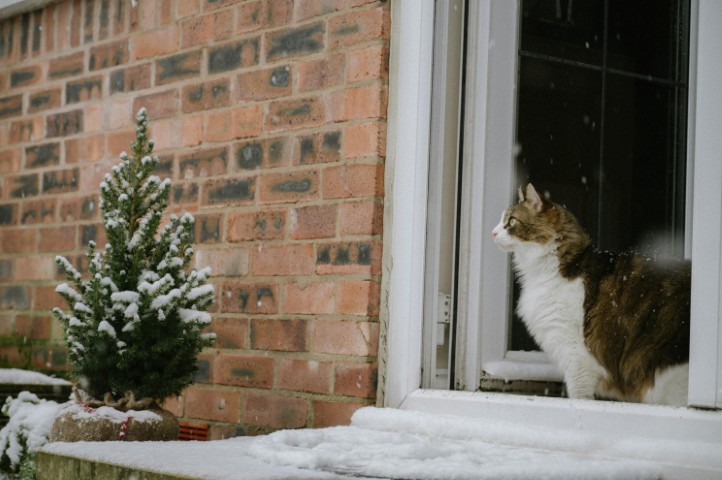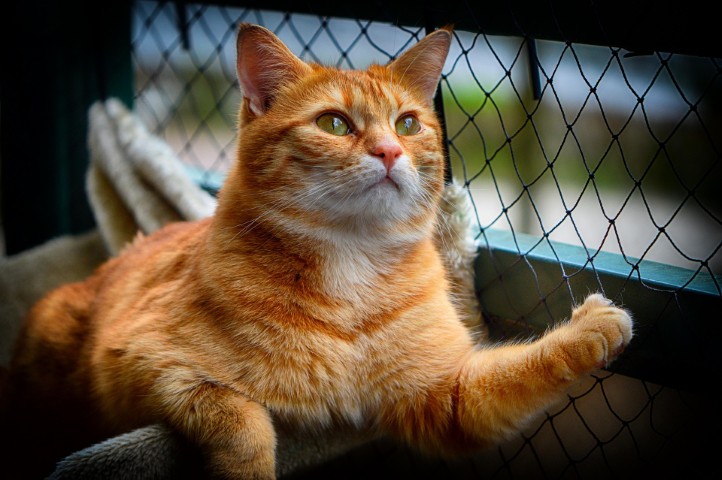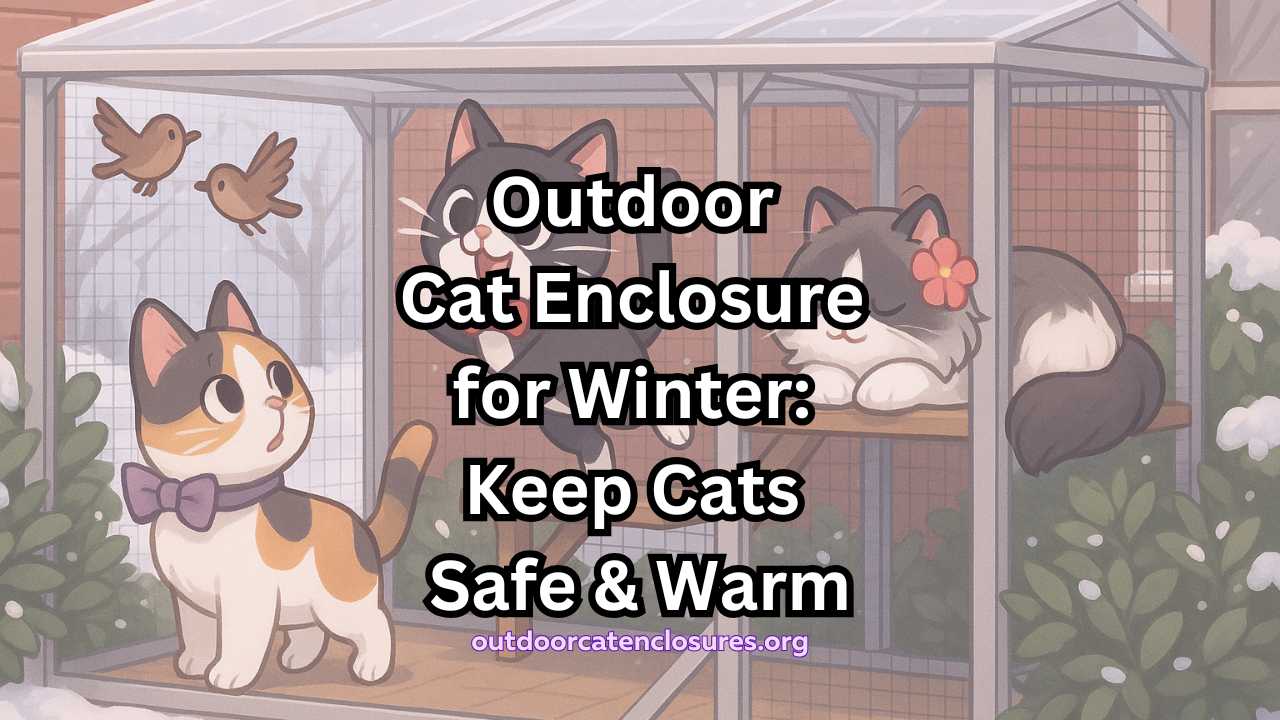When the air turns cold and frost starts forming on the windows, most of us grab a blanket to stay cozy indoors. But what about our cats?
They cuddle up with us more willingly indoors yet at some time, they still have that desire to go outside, pressing their noses against the glass, watching birds dart through the trees or leaves drifting in the breeze. It’s instinct. Cats crave fresh air, sunlight, and the excitement of the outdoors even when the temperatures drop.
Whether your cat is a city or country cat, it will always be drawn to the world outside. At the same time winter brings even more dangers. Hawks and coyotes get bolder when food is scarce. The temperature can fall fast and depending on what area you live in, snowstorms can whip up out of nowhereleaving your cat disoriented and unsafe to say the least.
That’s why it is important to have an outdoor cat enclosure for winter so that you can give your cat a safe space to explore nature while staying protected, warm, and dry. Whether you live in the country, suburbs, or even an apartment, you can create a similar space for your cat too.
So in this article I’m going to share some materials and methods that you can use to winterize your cat’s outdoor cat enclosure. If you have any questions or information to add, please feel free to share respectfully in the comments.
TL;DR Outdoor Cat Enclosure for Winter
Winter brings real challenges for outdoor cats including, but not limited to, freezing temperatures, harsh winds, and predators searching for food. An outdoor cat enclosure for winter gives your cat a safe way to enjoy the outdoors without the risks.
Place the enclosure in a sunny, sheltered spot and build it with or add in cat-safe materials like untreated wood, wire mesh, and clear polycarbonate panels. Add foam board insulation, straw bedding, and a solid roof to keep the space warm and dry.
A few simple upgrades that make a huge difference are the installation of raised flooring, wind protection, and soft resting areas. Making these adjustments will allow your cat to stay active, cozy, and secure all winter while you have peace of mind knowing they’re protected.
For more ideas, visit our Outdoor Cat Enclosures Hub to explore designs and seasonal guides.
In This Article You Will Explore
Why An Outdoor Cat Enclosure for Winter Matters

Cats are naturally curious and thrive on stimulation. Keeping them indoors all winter might keep them safe, but it can also leave them restless, bored, or anxious. If their needs are not met, they may pace by the windows, meow to go outside, or start showing unwanted behaviors like scratching or over-grooming.
This is why, even in the winter, giving your cat its outdoor time is important. Their desire to sniff fresh smells, cue in to listen for changing sounds, and a connecting with the world beyond the walls does not discipate with the warmth.
I want to emphasize the fact that letting cats roam freely, especially in winter, isn’t safe. Its no longer acceptable to say that ‘this is how its always been’ when available information shows us the opposite is true.
For instance, cold temperatures can cause frostbite and hypothermia in a matter of minutes while wild animals, neighborhood dogs, and traffic also pose serious risks to their safety. Even in cities, danger can come in unexpected ways such as icy rooftops, stray dogs or cats, and antifreeze spills that attract all too curious of cats.
An outdoor enclosure creates the perfect middle ground. It allows your cat to enjoy outdoor sights and smells without the risks. When built or winterized properly, it protects them from cold, wind, predators, and injury while still giving them freedom to explore safely.
Choosing the Right Spot for Warmth and Safety
Before you build or upgrade your cat’s winter enclosure, think carefully about placement. The right location makes a big difference in comfort and temperature.
Try to pick a south-facing spot that gets plenty of sunlight during the day. Sunlight naturally warms the space, even on cold days. Positioning the enclosure against your house or garage wall adds extra insulation and blocks cold wind. If you live in a windy area, use your fence or existing structures to your advantage. You can even add natural barriers like bushes or small evergreens for extra wind protection.
Keep the enclosure away from roads, driveways, or places where predators might pass through. If possible, place it where you can easily see your cat from inside the house. That way, you can check on them quickly if the weather changes or it starts to snow.
Accessibility matters too. Choose a spot that’s easy for you to reach so you can clean, refill water, and replace bedding without much trouble.
Cat-Safe Materials That Work in Cold Weather
Materials matter more than many people realize. Cats rub, scratch, and sometimes chew on everything around them, so it’s important to use cat-safe materials that can handle cold and moisture.
For the frame, look for or use untreated wood or cedar. These are durable, non-toxic, and won’t release harmful chemicals if your cat scratches or chews.
Avoid pressure-treated lumber, which may contain chemicals that aren’t safe for pets. Cover the structure with galvanized wire mesh that has small openings (one inch or less) to keep out predators like hawks and raccoons.
A solid roof is essential in winter. Clear polycarbonate panels or corrugated plastic sheets are excellent choices because they block snow and rain while letting sunlight through.
For insulation, use rigid foam board insulation sealed behind wood or plastic panels so your cat can’t claw it. On the floor, add straw not hay or blankets. Straw is the safest and warmest option because it stays dry and traps heat. Blankets tend to hold moisture and can freeze, making your cat colder.
Lastly, always use non-toxic sealants and paints designed for outdoor use. They’ll protect your enclosure from moisture and keep it looking nice without exposing your cat to harmful fumes or residues.
How To Winterize an Outdoor Cat Enclosure
If you already have a catio, you don’t need to start over. With a few thoughtful upgrades, you can easily prepare it for the winter months.
Start by blocking the wind. The cold wind is one of the biggest reasons cats get chilled. You can attach clear plastic panels, vinyl sheets, or even heavy-duty shower curtains to the sides of the enclosure. Clip them on tightly to keep the breeze out but still allow light in.
Next, focus on insulating the space. Line the inside walls with foam boards covered by plywood or plastic. This traps warmth and keeps drafts out. Add a thick layer of straw on the floor, and replace it whenever it gets damp.
If your cat spends several hours outside, you can also add a self-heating pet mat or an outdoor-safe heating pad. Just make sure it’s rated for pets and weatherproof. Place it in a dry corner so your cat can move away from it if they get too warm.
Lastly, elevate the enclosure a few inches off the ground. Even a small lift helps block cold air and moisture from seeping through the floor. You can use cinder blocks, wood pallets, or a simple wooden platform for this.
Creating a Cozy and Enriching Space

By nature, cats are adapt to warm weather so you can trust and believe that they appreciate a cozy, comfortable corner. Still, even during winter, they want to climb, stretch, and watch the world around them. Adding small touches can make your cat’s outdoor space both functional and fun.
You can include shelves or platforms at different heights so your cat can climb and perch. Also, add a small cubby box or enclosed area lined with straw for naps. A scratching post made of untreated wood gives them something to work their claws on, and hanging toys help keep them active.
If your cat enjoys watching wildlife, place a bird feeder nearby but far enough away so that birds feel safe to use it. Watching the movement of birds and squirrels is great enrichment, especially when outdoor playtime is shorter in winter.
I also like to add a few cozy touches, such as a fleece-lined bed inside a wooden box or a soft rug on one of the shelves. Just make sure anything fabric stays dry and can be easily replaced if it gets damp.
Simple Maintenance Tips for Winter Safety
Once your cat’s enclosure is ready, keeping it safe throughout winter is a lot easier with a little regular care.
Check the structure after every storm or heavy wind. If it snows in your area, remove snow buildup from the roof so it doesn’t get too heavy causing the roof to cave in. Replace straw if it gets wet or flattened and make sure the door and locks are working properly, since cold weather can cause metal to stiffen or rust.
Cats are obligate carnivores which means they should always have access to food and water. If you choose to put a little food in their enclosure, keep it in covered areas. Use heated bowls to prevent the water from freezing, and make sure dry food stays dry.
If you use a heating pad, check the cords often and make sure there’s no chewing or fraying.
And through all of this remember to watch for wildlife. Not only predators but also prey animals because in colder months, smaller animals sometimes look for warmth. Seal any openings big enough for them to squeeze through and inspect the area regularly.
A few minutes of maintenance can keep your cat’s outdoor space safe and warm all season long.
Adding Natural Elements for Beauty and Warmth
If you want to make your cat’s enclosure more natural, add a few cat-safe plants or shrubs around it. Evergreen bushes or ornamental grasses work well because they block wind and provide visual interest. They also attract birds, giving your cat something fun to watch.
Always double-check that your plants are safe for cats. Some common plants, like lilies and poinsettias, are toxic if eaten. You can use the ASPCA Toxic Plant List to check before planting anything near the enclosure.
Adding plants also helps your enclosure blend with your yard or garden, creating a space that’s both functional and beautiful year-round.
Key Takeaways – Outdoor Cat Enclosure for Winter
An outdoor cat enclosure provides freedom and safety.
It lets your cat enjoy the outdoors while staying protected from cold weather, predators, and other hazards.
Placement matters.
Choose a sunny, south-facing area that’s sheltered from wind and close to your home for added warmth and easy access.
Use cat-safe, weatherproof materials.
Build with untreated wood, galvanized wire mesh, and clear polycarbonate panels. Avoid pressure-treated lumber and toxic sealants.
Insulation and bedding are key.
Foam board insulation and straw bedding keep your cat warm and dry. Avoid blankets or towels since they hold moisture.
A solid roof and wind barriers help block the cold.
Use clear panels or heavy-duty plastic to protect from rain, snow, and wind while letting light through.
Keep it raised and maintained.
Elevate the structure to prevent moisture buildup and check it regularly for leaks, wear, or wildlife intrusion.
Add enrichment and comfort.
Shelves, scratching posts, and safe toys keep your cat happy and active even in colder months.
Check water and heat daily.
Use heated bowls or outdoor-safe pads when needed, and always ensure your cat can move away from any heat source.
Building or winterizing an outdoor cat enclosure for winter is one of the kindest ways to care for your feline friend. It keeps them safe, healthy, and connected to the outdoors all year long.
At The End of The Day
Building an outdoor cat enclosure for winter doesn’t have to be complicated. It’s about giving your cat a connection to the outdoors in a way that keeps them safe.
My cats spend their winter days lounging on their perches, watching the snow, and breathing fresh air without the risks that come with roaming. It brings me peace knowing they’re protected, warm, and happy.
You can give your cat the same gift. With a little planning, safe materials, and care, your cat can enjoy nature all year long. If you’d like to learn more, visit our Outdoor Cat Enclosures Hub for design ideas, safety tips, and seasonal guides.
Because our cats deserve more than safety — they deserve to live curiously, comfortably, and loved every day of the year.
What’s Next?
If you’re thinking about building or upgrading your cat’s space but don’t have a lot of room to work with, you’ll love our guide on the Best Outdoor Cat Enclosure for Small Yards.
It features doable ideas and top-rated enclosure recommendations that give your cat room to climb, play, and lounge even when space is limited. Whether you live in a small backyard, townhouse, or apartment setting, you’ll find plenty of inspiration to create a cozy outdoor haven your cat will adore.


A super helpful guide—winterising a catio is all about the micro-climate. What has worked for me: elevate the resting area, add windbreak panels on the prevailing-wind side (clear vinyl or polycarbonate), use straw instead of blankets (stays dry), and plug a weather-rated heated pad into a thermostatic outlet. I also seal drafts with foam strips, swap metal bowls for ceramic, and hang a few fleece flaps so they can choose warmer “rooms.” Quick thought: a simple hygrometer inside helps you catch condensation before it becomes a chill risk. Curious—have you tested clear roof panels vs. solid for passive solar on cold, sunny days?
Marios
Hi Marios,
This is such a fantastic and insightful comment and thank you for sharing your experience!
You’re absolutely right that micro-climate control makes all the difference in winter cat enclosures. I love your point about using straw instead of blankets and adding a hygrometer as both are smart, often-overlooked details that can really improve comfort and safety.
As for your question about roof panels, yes, I’ve experimented with both clear and solid options. Clear polycarbonate panels tend to perform better on cold, sunny days since they trap gentle warmth without blocking light, especially when angled properly for sun exposure. The key downside is condensation buildup, which is where your hygrometer tip comes into play.
Solid panels, on the other hand, provide more consistent insulation during extended overcast periods but lose some of that passive solar benefit.
I’m planning a dedicated comparison piece on roofing materials for outdoor cat enclosures soon which will include the pros and cons of clear versus solid panels through different seasons since it’s such an important part of creating a stable environment.
Thank you again for your thoughtful contribution and for adding so much value to the discussion!
— Marlinda
This is such a helpful and necessary guide for cold-weather cat care! I’ve been wondering how to safely extend my cat’s outdoor time during the winter without compromising his comfort. Your tips on windbreaks, insulated bedding, and ensuring access to an unfrozen water source are exactly the kind of practical advice I was looking for. Thank you for thinking of both the cats’ happiness and their safety!
Hi Cian,
Thank you so much for your thoughtful comment, I’m really happy the guide gave you the clarity you were looking for!
It’s wonderful that you’re taking the time to think through How To Keep Your Cat Safe and Content During The Colder Months. That balance makes such a difference for their overall well-being.
Windbreaks and proper insulation really do go a long way, and ensuring unfrozen water is one of those details that’s easy to overlook but so important for hydration. If you haven’t already, make sure to bookmark the section on Winterizing Outdoor Cat Shelters helpful as it covers a few more ways to fine-tune your setup for comfort and energy efficiency.
Thanks again for reading and for being such a caring cat parent. I’m sure your cat will love the extra outdoor time this winter!
— Marlinda
This was such a helpful and heartwarming article, Marlinda. I like how you balanced safety, comfort, and enrichment for outdoor cats during winter. The details about insulation and straw bedding were especially useful. Have you found a particular type of heated pad or setup that works best for cats who spend several hours outside on very cold days?
John
Hi John,
I’m so glad you found the article helpful and thank you for your kind words! You’re absolutely right that balancing warmth, safety, and stimulation is key when cats spend time outside in winter.
It’s all about creating a space where they can stay cozy while still being able to enjoy their surroundings.
When it comes to heated pads, I’ve had great success with thermostatically controlled outdoor heating pads designed specifically for pets. I personally like the K&H Pet Products Lectro-Soft Outdoor Heated Bed, since it’s weather-resistant, energy-efficient, and soft enough for cats to snuggle into without overheating.
I always recommend placing it on top of a layer of straw or an insulated mat for extra warmth and safety.
We’ll be covering a full comparison of the best heated pads and shelters for outdoor cats soon, including tips on positioning and power safety. That’ll be a great resource for anyone setting up a winter catio.
Thank you again for reading and for your thoughtful question, John, it’s always a pleasure to hear from you!
— Marlinda